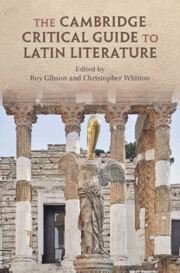Book contents
- The Cambridge Critical Guide to Latin Literature
- The Cambridge Critical Guide to Latin Literature
- Copyright page
- Dedication
- Contents
- Figures and Tables
- Contributors
- Preface
- Abbreviations
- Chapter 1 Introduction
- Chapter 2 Canons
- Chapter 3 Periodisations
- Chapter 4 Author and Identity
- Chapter 5 Intertextuality
- Chapter 6 Mediaeval Latin
- Chapter 7 Neo-Latin
- Chapter 8 Reception
- Chapter 9 National Traditions
- Chapter 10 Editing
- Chapter 11 Latin Literature and Linguistics
- Chapter 12 Latin Literature and Material Culture
- Chapter 13 Philosophy
- Chapter 14 Political Thought
- Chapter 15 Latin Literature and Roman History
- Chapter 16 Latin Literature and Greek
- Envoi
- Index Locorum
- General Index
- References
Chapter 5 - Intertextuality
Published online by Cambridge University Press: 04 January 2024
- The Cambridge Critical Guide to Latin Literature
- The Cambridge Critical Guide to Latin Literature
- Copyright page
- Dedication
- Contents
- Figures and Tables
- Contributors
- Preface
- Abbreviations
- Chapter 1 Introduction
- Chapter 2 Canons
- Chapter 3 Periodisations
- Chapter 4 Author and Identity
- Chapter 5 Intertextuality
- Chapter 6 Mediaeval Latin
- Chapter 7 Neo-Latin
- Chapter 8 Reception
- Chapter 9 National Traditions
- Chapter 10 Editing
- Chapter 11 Latin Literature and Linguistics
- Chapter 12 Latin Literature and Material Culture
- Chapter 13 Philosophy
- Chapter 14 Political Thought
- Chapter 15 Latin Literature and Roman History
- Chapter 16 Latin Literature and Greek
- Envoi
- Index Locorum
- General Index
- References
Summary
Since Kristeva invented the term in the late 1960s, intertextuality has become a dominant concern in Latin literature, despite the fact that Latinists often use the term in a narrow sense. A brief history of intertextuality enables this chapter to model different understandings of intertextuality across different genres and periods. Consideration begins with a passage of Virgil long recognised as a calque of Homer, and moves to other maximal cases of intertextuality in Plautus and Terence. Awareness of the dynamics and ideological power of intertextuality enables fuller consideration of the metaphors with which such passages as these comment on their situation in wider networks of text. The importance of historical context is discussed through several phenomena prevalent in late antiquity, namely cento poetry, compilation and typological interpretation. Developments across these periods in the technology of text focus attention on the cognitive and material dimensions of memory. The chapter closes by putting intertextual memory in Latin literature into dialogue with emerging methods of reading enabled by digital corpora, search algorithms, hypertext and linked data.
Keywords
- Type
- Chapter
- Information
- The Cambridge Critical Guide to Latin Literature , pp. 208 - 271Publisher: Cambridge University PressPrint publication year: 2024

